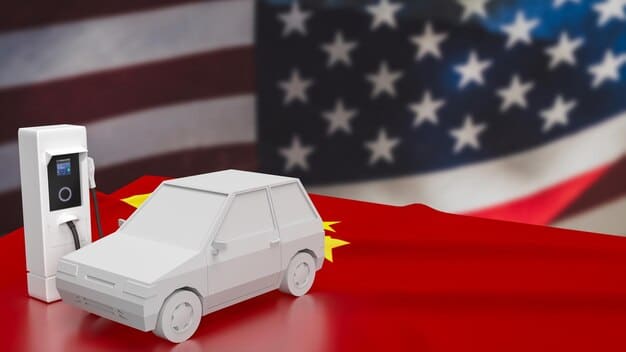Latest US Government Incentives Boosting Electric Vehicle Sales

Latest government incentives in the US, such as tax credits and rebates, significantly impact electric vehicle (EV) adoption by reducing upfront costs and encouraging consumers to switch to EVs, ultimately boosting sales.
The landscape of electric vehicle adoption in the United States is rapidly evolving, fueled by a growing awareness of environmental concerns and advancements in EV technology. Central to this transformation are the latest government incentives for electric vehicle adoption in the US and how do they affect sales, designed to make EVs more accessible and appealing to a broader consumer base.
Understanding Federal Tax Credits for Electric Vehicles
Federal tax credits form a cornerstone of the U.S. government’s strategy to promote electric vehicle adoption. These credits aim to lower the initial cost barrier, making EVs more competitive with traditional gasoline-powered cars. Understanding the specifics of these credits is crucial for both consumers and manufacturers.
The Inflation Reduction Act and EV Tax Credits
The Inflation Reduction Act (IRA) of 2022 brought significant changes to the federal EV tax credit. It introduced new requirements and eligibility criteria, impacting which vehicles qualify and how much credit consumers can receive.
Eligibility Requirements for the Federal Tax Credit
To be eligible for the federal tax credit, EVs must meet certain criteria related to battery components and critical mineral sourcing. These requirements are designed to encourage domestic manufacturing and sourcing of EV components.
- Income Limits: The IRA introduced income limits for individuals and families to qualify for the tax credit.
- Vehicle Price Caps: There are price caps on eligible vehicles, varying based on the vehicle type (e.g., sedans, SUVs, trucks).
- Battery Components: A percentage of the battery components must be manufactured or assembled in North America.

The federal tax credit provides a substantial financial incentive, but navigating the eligibility requirements can be complex. Consumers should carefully review the guidelines and consult with tax professionals to determine their eligibility. The changes introduced by the Inflation Reduction Act represent a significant shift in the landscape of EV incentives, promoting domestic manufacturing and broader access to electric vehicles.
State-Level Incentives and Rebates for EVs
In addition to federal tax credits, many states offer their own incentives to encourage electric vehicle adoption. These state-level programs vary widely in terms of eligibility requirements, funding levels, and types of incentives offered. They play a crucial role in accelerating EV adoption across the country.
Overview of State EV Incentive Programs
State EV incentive programs include rebates, tax credits, grants, and other financial incentives. These programs are often designed to complement federal incentives and address specific regional priorities.
Examples of State Rebate Programs
California, Massachusetts, and New York are examples of states with robust EV rebate programs. These programs offer cash rebates to eligible consumers who purchase or lease new electric vehicles.
- California Clean Vehicle Rebate Project (CVRP): Offers rebates up to $7,500 for eligible EVs.
- Massachusetts MOR-EV Program: Provides rebates up to $2,500 for new EVs.
- New York Drive Clean Rebate: Offers rebates up to $2,000 for eligible EVs.
State-level incentives can significantly reduce the cost of EV ownership, making electric vehicles more attractive to consumers. These programs often target specific demographics or geographic areas to maximize their impact. By combining federal and state incentives, consumers can realize substantial savings when switching to electric vehicles.
The Impact of Incentives on Electric Vehicle Sales
Government incentives have a direct and measurable impact on electric vehicle sales. By reducing the upfront cost and offering financial benefits, incentives make EVs more competitive with traditional gasoline-powered vehicles. Understanding this impact is essential for policymakers and industry stakeholders.
Analyzing Sales Data Before and After Incentive Programs
Sales data consistently shows a significant increase in EV sales following the introduction or expansion of incentive programs. This trend demonstrates the effectiveness of incentives in driving consumer behavior.
Case Studies of Successful Incentive Programs
Several states and countries have implemented successful incentive programs that have led to significant increases in EV adoption. These case studies provide valuable insights into best practices and program design.

- Norway: Offers generous tax incentives and subsidies, resulting in one of the highest EV adoption rates in the world.
- California: Strong state incentives, combined with federal credits, have made California a leader in EV sales in the U.S.
- China: Government subsidies and policies have driven significant growth in the Chinese EV market.
Incentives play a crucial role in overcoming the initial cost barrier and accelerating the transition to electric vehicles. By studying successful programs and analyzing sales data, policymakers can refine incentive strategies to maximize their impact. The effectiveness of incentives is evident in the growing adoption rates of EVs across the globe.
Challenges and Criticisms of Current Incentive Structures
While government incentives have proven effective in boosting EV sales, they are not without their challenges and criticisms. Addressing these concerns is essential for ensuring the long-term sustainability and effectiveness of incentive programs.
Equity Issues and Access to Incentives
Some critics argue that current incentive structures disproportionately benefit higher-income individuals who are more likely to purchase new vehicles. Addressing equity issues is crucial for ensuring broader access to the benefits of electric vehicles.
Sustainability of Long-Term Incentive Programs
The long-term sustainability of incentive programs is a concern, as government funding may not always be available. Exploring alternative funding mechanisms and strategies for phasing out incentives over time is essential.
Equity issues and the sustainability of long-term incentive programs are two critical challenges facing current EV incentive structures. Policymakers must address these issues to ensure that the benefits of electric vehicles are accessible to all and that incentive programs remain effective and sustainable over time. Addressing these challenges is crucial for the continued growth and success of the electric vehicle market.
The Future of Government Incentives for Electric Vehicles
The future of government incentives for electric vehicles is likely to involve a combination of strategies aimed at addressing current challenges and promoting long-term sustainability. Adapting to changing market conditions and technological advancements is essential for maximizing the impact of incentives.
Potential Changes in Federal and State Policies
Potential changes in federal and state policies could include adjustments to eligibility requirements, funding levels, and types of incentives offered. These changes will likely be influenced by evolving market dynamics and policy priorities.
The Role of Infrastructure Development in Supporting EV Adoption
Infrastructure development, particularly the expansion of charging networks, plays a crucial role in supporting EV adoption. Government investments in charging infrastructure can complement incentive programs and address range anxiety concerns.
The future of government incentives for electric vehicles will likely involve a combination of strategies, including adjustments to policies and investments in infrastructure development. By adapting to changing market conditions and addressing current challenges, policymakers can maximize the impact of incentives and promote the widespread adoption of electric vehicles. The role of infrastructure development is crucial in supporting EV adoption and addressing range anxiety.
How Manufacturers are Responding to Government Incentives
Electric vehicle manufacturers are keenly aware of the impact of government incentives on consumer behavior. They are responding to these incentives by adjusting their product offerings, pricing strategies, and manufacturing processes to maximize eligibility and appeal to a broader market.
Adjustments to Manufacturing and Pricing Strategies
Manufacturers may adjust their manufacturing and pricing strategies to ensure that their vehicles meet the eligibility requirements for federal and state incentives. This could include sourcing battery components from North America or lowering vehicle prices to meet price caps.
Collaborations Between Manufacturers and Government Agencies
Collaborations between manufacturers and government agencies are becoming increasingly common. These collaborations can help to align industry efforts with policy goals and promote the long-term growth of the electric vehicle market.
Electric vehicle manufacturers are actively responding to government incentives by adjusting their manufacturing and pricing strategies and collaborating with government agencies. These efforts are aimed at maximizing eligibility for incentives and promoting the widespread adoption of electric vehicles. The collaboration between manufacturers and government agencies is crucial for aligning industry efforts with policy goals and promoting the long-term growth of the electric vehicle market.
| Key Point | Brief Description |
|---|---|
| 💰 Federal Tax Credits | Reduces EV purchase price with tax credits up to $7,500. |
| 🌎 State Rebates | Additional rebates offered by states like California and New York. |
| 📈 Sales Impact | Incentives lead to increased EV sales and adoption rates. |
| 🔋 IRA Compliance | New rules require local sourcing of battery parts for tax credits. |
Frequently Asked Questions
▼
The maximum federal tax credit for eligible electric vehicles is $7,500. This credit can significantly reduce the overall cost of purchasing a new EV, making it more competitive with traditional gasoline cars.
▼
Yes, the Inflation Reduction Act introduced income limits for individuals and families to qualify for the federal EV tax credit. These limits ensure that the incentives are targeted towards those who need them most.
▼
Yes, in many cases, state incentives can be combined with the federal tax credit, providing even greater savings for EV buyers. States like California and New York offer additional rebates.
▼
The Inflation Reduction Act introduced significant changes to the federal EV tax credit, including new eligibility requirements related to battery components and critical mineral sourcing. It aims to boost domestic manufacturing.
▼
Government incentives are crucial because they lower the upfront cost of EVs, making them more accessible to a wider range of consumers and accelerating the transition away from gasoline-powered vehicles.
Conclusion
Government incentives are a driving force behind the increasing adoption of electric vehicles in the United States. Federal tax credits and state-level rebates significantly reduce the cost of EV ownership, making them a more attractive option for consumers. By understanding the latest incentives and how they impact sales, both consumers and manufacturers can make informed decisions that contribute to a more sustainable transportation future.





